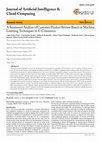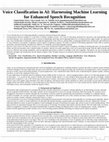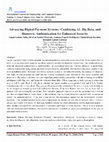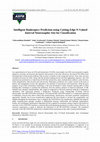Papers by Venkata Nagesh Boddapati

The use of customer evaluations as a basis for purchasing decisions has grown in importance with ... more The use of customer evaluations as a basis for purchasing decisions has grown in importance with the meteoric rise of e-commerce in the last several years. Reviews provide businesses with valuable information and foster trust, in addition to helping potential customers make informed decisions. A comprehensive examination of a dataset including reviews from Amazon that spans many product categories was part of this research. This SA project's primary goal is to categorise Amazon reviews as neutral, negative, or positive using a BERT model. A study involves several key stages, including data preprocessing, collection, splitting, model training, and evaluation. The JSON-formatted reviews of items sold by Amazon were compiled, including devices like mobile phones, laptops, televisions, tablets, and video security systems. Preprocessing steps included lowercasing, removal of stop words, punctuation, contractions, tokenization, and part-of-speech tagging. Sentiment scores were generated using an opinion lexicon, and word embeddings were applied for numerical vectorization. Employing a cross-entropy loss function trained inside the PyTorch framework, a BERT model was used for sentiment categorisation. To measure how well the model performed, we employed evaluation criteria like recall, F1-score, precision, and accuracy. BERT achieved superior results compared to logistic regression and decision tree models, demonstrating its ability to capture long-term dependencies in textual data. Empowering e-commerce platforms to make educated judgements and expand their service offerings, these results have substantial practical consequences and will give them confidence in their strategy.

• Voice Classification in AI: Harnessing Machine Learning for Enhanced Speech Recognition • Commu... more • Voice Classification in AI: Harnessing Machine Learning for Enhanced Speech Recognition • Communication between machines is at the heart of modern computer science. As a form of technology developed for interaction and understanding with concerned humans, voice classification (VC) is a means of identifying, observing, and recognizing human voice in natural acoustic signal sounds. As a practical case, voice classification is immensely useful in numerous applications, with a focus on, among others, (i) language identification, (ii) detection and notification of voice biometrics, (iii) speaker recognition, and (iv) speech recognition in general. The latter is required in developing augmented reality (AR) in assistive technology, educational games, learning from children's TV programs, and foreign language learning. • However, some factors can affect the accuracy of a current voice classification model in speech recognition, including (i) background noise, (ii) microphone effects, and (iii) environments with a variable number of speakers. Speech as an audio signal plays a key role in speech processing. With the rapid evolution and access to collection and storage capabilities, much-unorganized speech data on speech is available at the user's fingertips. That speech can also be produced, animated, managed, and incorporated into the human-computer Unity VR game resources via advanced speech processing technology and artificial intelligent voice agents.

nternational Journal Of Engineering And Computer Science, 2022
Digital payment solutions have recently gained extraordinary popularity across the globe. Many... more Digital payment solutions have recently gained extraordinary popularity across the globe. Many individualsin cities or urban areas have begun to use these payment systems for financial transactions. The combined use of different advanced technologies is indispensable for widespread adoption. Various obstacles to performing financial transactions using digitalpayment systems must be considered. Among these obstacles, security is the most remarkable point. Although this online payment system is fast and convenient, the chances of fraud are very high. A cybercriminal can hack into the system, stealing personal information like phone numbers and passwords. This article will focus on a new digital payment security system that will take advantage of artificial intelligence (AI), big data, and biometric authentication (BA). When using this security system, a transaction request will be sent. First, it will check whether the phone number is a registered user and if it is, further authentication will be carried out. The system will automatically authenticate the user’s identity with the help of facial recognition technology that will analyze the features of the face. Further, the user has to show various gestures that are analyzed by the system. This and other personal information will be converted into a number and then encrypted before being stored in the database. Theincoming transaction request will be compared against the personal number. If the user is not unique, the transaction request will be immediately rejected. Secondly, if the number matches but the user is fraudulent, the transaction will also be rejected. Only if both are unique, the system will check for duplicate numbers among the other transactions for the particular period. If other numbers are not found, the transaction is executed; otherwise, it is still rejected. This is done to find out fake and auto-generated numbers. This security system will be helpful to ensure the authenticity of the user in digital payment systems.Keywords: Digital Payment Solutions, Financial Transactions, Advanced Technologies, Security, Fraud, Artificial Intelligence (AI),Big Data, Biometric Authentication (BA), Facial Recognition, Encryption

Educational Admisistration:Therory and practice
Biometric data, including keystroke dynamics and voice data, is being employed by banks to authen... more Biometric data, including keystroke dynamics and voice data, is being employed by banks to authenticate the identity of users making digital payments. This data is being analyzed using artificial intelligence tools to detect any fraud attempts. The biometric data of users making online transactions is compared to their previous data collected when they used mobile banking, internet banking, and other banking services. If this biometric data is found to fluctuate beyond a certain threshold, the transaction is flagged as a possible fraud. This mechanism is proving beneficial as a large number of fraud attempts are being detected in the early stages before losses amounting to crores of rupees occur. Big data, a very large set of information that is complex and difficult to manage, is being used to aid a machine learning-based fraud detection system in making predictions. Looking at the pattern of transactions already made alongside the claims of fraud against these transactions allows for past transactions to be classified as any of the two classes of predicting fraud: ‘fraud’ and ‘not fraud’. Based on these credible past transactions, future transactions can also be predicted, and frauds attempted can be classified as ‘true positive’, ‘false positive’, ‘true negative’, or ‘false negative’. Also, multiple decisions concerning the model of classifying fraud can be considered simultaneously if big data is employed in the machine learning model. This technology is extremely useful for banks to detect fraud early in the transaction process.
educational administration, 2023
AI-powered insights are becoming increasingly essential in every industry. The cost of doing geno... more AI-powered insights are becoming increasingly essential in every industry. The cost of doing genomic science is becoming comparable to 'big data' requirements, leading to a need for data-driven insights. This essay will investigate how AI-powered insights can build and expand the data-rich and bias-free genomic insights needed in healthcare, with a particular focus on DNA collection and genomic DNA-based healthcare research. Many challenges will be discussed during this paper should the data ecosystem be expanded to include many more humans worldwide or focused on the increasingly complex data types associated with post-genomic healthcare. We will also explore the AI methods likely to make significant breakthroughs in the future and will need further investment.
Educational Administration:theory and practice, 2019

International Journal of Neutrosophic Science , 2024
As a generalization of fuzzy set (FS) and intuitionistic FS (IFS), neutrosophic sets (NS) were pr... more As a generalization of fuzzy set (FS) and intuitionistic FS (IFS), neutrosophic sets (NS) were proposed to signify imprecise, uncertain, inconsistent and imperfect data present in real-time. Moreover, the interval NS (INSs) were developed just to find out the problems with an array of statistics in the actual unit interval. Then, there are least consistent processes for INSs, along with the decision-making process and INS aggregation operator. The vital operations are presented on n-valued interval NSs like intersection, union, multiplication, addition, scalar division, scalar multiplication, false-favorite and truth favorite. Bankruptcy prediction was a major concern in the areas of finance and management science that appealed to the attention of practitioners and researchers. With the great progress of up-to-date information technology, it has been developed to utilize machine learning (ML) or deep learning (DL) techniques to perform the prediction, from the primary analysis of financial statements. If ML methods have adequate interpretability, they might be employed as effectual analytical methods in bankruptcy calculation. This manuscript presents a Bankruptcy Prediction using Cutting-Edge N-Valued Interval Neutrosophic Sets (BP-CENVINS) mechanism. The projected BP-CENVINS method is a complicated approach to bankruptcy forecast that affects radical data preprocessing, classification, and hyper parameter optimization approaches. Initially, the Z-score normalization regularizes the fiscal details to increase the comparability and stability throughout the information. Next, it employs the CENVINS for the classification, skillfully detecting the subtle communication amongst variables to differentiate between creditworthy and bankrupt organizations. Finally, the Grasshopper Optimization Algorithm (GOA) is applied for parameter tuning to improve the predictive outcomes of the CENVINS classifiers, systematically purifying design parameters to achieve finest efficiency. An extensive experiments is made to illustrate the betterment of the BP-CENVINS technique. The simulation outcomes of the BP-CENVINS method have exhibited better performances than other existing methodologies

Uploads
Papers by Venkata Nagesh Boddapati